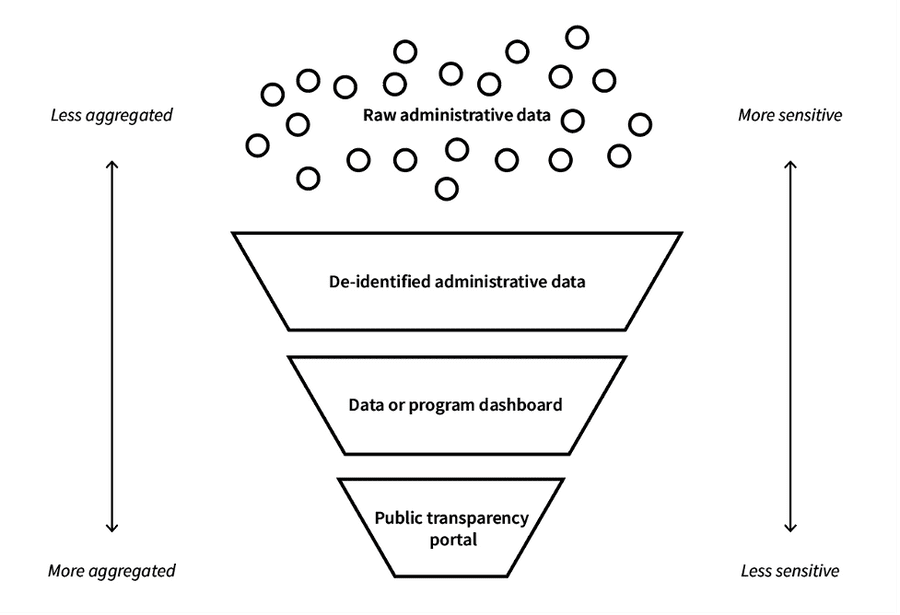How can states pay for integrated data and evaluation capabilities?
Project Summary
To better serve citizens and communities, state and local governments need a new approach to data and evaluation. By blending and braiding different programmatic funding streams and evaluating different operational structures, state and local leaders – from governors, cabinet secretaries and CIOs to county executives, program directors and grant recipients – can make tremendous strides toward better data-based decision-making. Federal dollars – including stimulus funds, program-specific grant funds, and project-specific funds – as well as direct state or local appropriations can be combined to create cross-program data-sharing and integration strategies.
See our paper.
Why is this issue important?
Investing in integrated data systems that bring together education, workforce, health, and social services programs is critical because so many programs target the same client populations. Integrated data can break through the bureaucratic silos – optimizing service delivery and enabling program evaluation. The federal government now spends over $1 trillion annually on grants to state and local governments. In 2022, over $900 billion was allocated to programs serving low-income and vulnerable populations, including health, nutrition, income support, education, employment, housing, criminal justice, transportation and other social services.
Few states and localities are able to determine how well their programs – individually and in combination – meet the needs of their populations. The key is having organized data – and having people with the right skill sets and permissions to work with that data. Integrated data and improved evaluation capacity can drive better outcomes, reduce program costs, improve public transparency, ensure regulatory compliance and even detect and reduce fraud.
What did we do?
The biggest benefit of integrated data systems is its biggest challenge: working with multiple government programs. Each program has different funding rules, timelines, and goals. There are too many for a government data analytics shop to be an expert in all of their administrative minutia. Nonetheless, some state and local governments had built amazing systems with dozens of programs. How had they done it?
We spent the first few months interviewing leading programs, suggested to us by Actionable Intelligence for Social Policy, in Allegheny County, Colorado, Indiana, Kentucky, Ohio, Rhode Island, and Washington. They had built their systems in a variety of ways - a strong executive vision, using outside partners, “paying the rent” with required work to enable higher level analytic work, delivering crucial analysis that motivated policy makers to deliver direct state funding, and figuring out how to braid and blend funds from multiple federal grant sources.
The next phase of the project involved vetting these strategies with a variety of outside entities.
- Public interest groups - What are necessary qualities of state and local integrated data systems to really benefit the public?
- Other state and local governments that had or were contemplating integrated data systems - Would these strategies work in your situation?
- Federal grant and program experts - Would audit rules make some of these strategies a problem?
What have we learned (so far)?
Without modern, efficient integrated data systems, progress by federal, state and local governments in using data and evidence to improve decision-making will be slow and incomplete. But we are so close. Leading states and localities serve as proof points of the outsized benefits that centralized systems can offer in return for a modest investment.
The varied approaches they have used to finance their systems have created a menu of options available to state and local leaders whose integrated systems are at different stages of maturity and operate under different governance structures. There is a path for every state and local government to bring integrated data and robust evaluation to their organizations.
While states and localities can strengthen and expand integrated data systems, the federal government could take important steps to accelerate state and local progress. State and local governments are hobbled by fear and uncertainty. Uncertainty that the path to integrated data is fully supported by dozens of federal programs and fear that auditors and regulators will stop them from making progress. The U.S. Office of Management and Budget (OMB) and federal agencies could implement coordinated regulatory and administrative actions to make it substantially easier for states and localities to finance systems by blending and braiding existing federal funding streams and to shift to more cost-efficient, secure, cloud-based technology solutions.
What happens next?
In March 2023 we led an effort to respond to OMB’s request for suggestions to improve title 2 of the Code of Federal Regulations - the rules for the federal grant-making process. We were thrilled to get dozens of former and current government officials and related organizations to sign on to recommendations stemming from this project. Hopefully, OMB will see the value in some of these recommendations, and we can make it easier for state and local governments to use federal resources to improve these hugely important client facing programs.
If you are interested in bringing integrated data and evaluation to your city or state, we’d love to get in touch! Drop us a line at thepolicylab@brown.edu.
What happened behind the scenes?
It was amazing to see the variety of organizations whose memberships have struggled with this issue; from the National Association of State Chief Information Officers to the American Public Human Services Association to the Council of Chief State School Officers. At the same time, everyone was sharing ideas, workarounds and strategies to build integrated data and evaluation capacity. There were no secrets between dedicated public servants.
How to cite this Project: The Policy Lab. (2023, March 29). How can states pay for integrated data and evaluation capabilities?. The Policy Lab. https://thepolicylab.brown.edu/projects/how-can-states-pay-for-integrated-data-and-evaluation-capabilities


